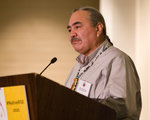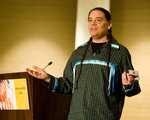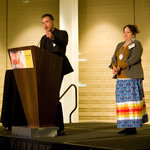




Many buildings that serve Native Americans across the Twin Cities are outdated and dilapidated, making it even tougher to help those in need, according to Dr. Joe Hobot, president and CEO of the American Indian Opportunities Industrialization Center (AIOIC) in Minneapolis.
“Our aging facilities are being held together by baling wire, duct tape, spit and grip,” he told the attendees at the recent #NativeRISE event in downtown St. Paul.
Hobot was speaking on behalf of a newly formed collaborative called the Urban Indigenous Legacy Initiative, a plan to transform the Indigenous landscape of the Twin Cities. The collaborative represents 16 nonprofit organizations working on behalf of Native Americans metro-wide; the buildings that house these organizations are in need of repair and/or replacement.
These organizations have provided services and resources in the Twin Cities for more than four decades. The proposed culturally affirming buildings would allow the organizations to expand the services they offer, creating a safe, supportive, and empowering experience for Native Americans recipients.
At this moment, with historic levels of funding available for improving infrastructure and reducing racial disparities, the Urban Indigenous Legacy Initiative is looking forward.
Thriving nonprofits =
thriving communities
The #NativeRISE event drew approximately 200 nonprofit leaders, legislators, foundation supporters, community partners, media and other guests. As the audience learned, six of the proposed Legacy Initiative projects are shovel-ready, five are investment-ready, and the rest are still being planned.
The estimated cost for the project is $94 million, which will be raised through public and private sources.
The Legacy Initiative addresses disparities highlighted during the COVID-19 pandemic and recent civil unrest, as well as persistent shortfalls in funding for capital improvements in Native American organizations that focus resources on client services.
“Now is the time to commit to funding state-of-the-art facilities with robust programming for the Native American community,” Hobot said. “The challenges of the last 20 months have been unprecedented. It’s time to build the future we want to see for our people.”
Power of community
Annessia Swann was 22 years old in 1994. Speaking from the podium at #NativeRISE, she said, “I was a single mom in an abusive relationship and needed career assistance to raise my son. A family member suggested I go to the American Indian OIC.”
“I signed up for a one-year training program. The OIC had an on-site child care center, which made it possible for me to complete my program. I found work after I graduated, first with a marketing firm and then in a corporate setting. After a few years, I got a job at OIC, and I’ve been there ever since. I grew up there. My kids would say they grew up there.”
Swann, now the director of Adult Basic Education/GED at AIOIC, is grateful for the support and services she received from the organization. It has made a difference in her life, she said.
The Legacy Initiative will make it possible for AIOIC, located at 1845 E. Franklin Ave. in Minneapolis, to expand and improve its facilities. Funding will ensure that students at the on-site high school have an enriched learning environment with up-to-date technology and resources. Students in the job training program will receive career counseling and skills that help them enter, reenter or advance in the workforce with living wage jobs.
The Legacy Initiative will make it possible for the OIC, located at 1824 Franklin Ave. East in Minneapolis, to expand and improve its facilities. Those facilities include the the on-site high school Takoda Prep, and the job training program Takoda Institute. Takoda is a Dakota word meaning “friend to all.”
Importance of cultural spaces
Attorney Patrice Kunesh is board chair of the Wakan Tipi Center and Lower Phalen Creek Project on the east side of St. Paul. From the podium, she explained, “We’re trying to restore land to its original habitat. We’ve transformed 27 acres desecrated by the railroad and by industry at the Bruce Vento Nature Sanctuary.”
The organization’s goal is to honor and bring connection to the sacred site. The building – deemed “shovel ready” – will feature a community gathering area, classrooms, and gallery space to showcase the value of sanctuary as a place for cultural healing, life-long learning, and inspiration.
Once built, the organization will operate the interpretive center rent-free for 30 years, as part of a public/private partnership with the city of Saint Paul.
“We’re very grateful,” Kunesh said, “to the city, the legislature, the state, the Met Council, local philanthropists and foundations for supporting a gathering place that will benefit Native Americans and the whole community.”
Reclaiming Indigenous food pathways
Indigenous chef Sean Sherman has spent more than 30 years perfecting his craft. Co-founder (with his partner Dana Thompson) and CEO of the Sioux Chief, the Indigenous Food Lab, and Owamni, the new Indigenous restaurant in downtown Minneapolis, he was the keynote speaker for #NativeRISE.
“North America’s history begins with Indigenous history. Now is the time to step up all together. Now is the time for evolution and revolution,” Sherman said. “We are reclaiming Indigenous narratives, Indigenous spaces, and Indigenous food pathways that were broken with colonization. We will be the answer to our ancestor’s prayers, but we can’t do it by ourselves. We will rise together.”
For further information about the Urban Indigenous Legacy Initiative, contact Ann Merrill at the American Indian OIC: annm@aioic.org.
Funding for #NativeRISE was provided by the Bush Foundation and Bremer Bank. Singing and drumming was provided by the West End Singers.
Comments
No comments on this item Please log in to comment by clicking here